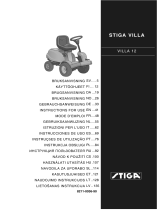
Sikkerhedsmærkatikoner
ADVARSEL: Læs, og gør dig bekendt med
betjeningsvejledningen, inden du bruger denne maskine. Vær
bekendt med placeringerne og funktionerne af alle
betjeningsanordninger. Du må ikke bruge denne maskine,
medmindre du har lært at bruge den.
1
FARE - TAB AF TRÆKKRAFT, SKRIDNING, STYRING OG
HERREDØMME PÅ SKRÅNINGER: Hvis maskinen ikke vil køre
fremad eller begynder at skride på en skråning, skal du standse
klipningen og langsomt køre væk fra skråningen.
2
FARE: BRANDFARE: Hold maskinen ren for græs, blade og
overskydende olie. Påfyld ikke brændstof, når motoren er varm
eller kører. Stop motoren, udtag nøglen, og lad den køle af i mindst
tre minutter, før du fylder brændstof på. Fyld ikke brændstof på
indendørs eller i en lukket anhænger eller garage eller andre
indelukkede områder. Tør spildt brændstof op. Ryg ikke under
betjening af denne maskine.
3
FARE - FOR AT VÆLTE OG SKRIDE: Slå græs op og ned og
ikke på tværs af skråninger. Må ikke betjenes på skråninger, som
er stejlere end 10 grader. Undgå pludselige og skarpe (hurtige)
sving på skråninger.
4
FARE - AMPUTATION OG ALVORLIG LEMLÆSTELSE: For at
undgå ulykker fra roterende skær og bevægelige dele skal du
sørge for, at sikkerhedsanordningerne (skærme og kontakter) er
på plads og er funktionsdygtige.
5
Undlad at slå græs, når der er børn eller andre personer i
nærheden. Tag aldrig passagerer med, specielt ikke børn, heller
ikke selvom skærene er slået fra. Slå ikke græs i bakgear,
medmindre det er ubetinget nødvendigt. Kig dig tilbage og nedad
før og mens du bakker.
6
Se den tekniske manual, inden du udfører reparationer eller
vedligeholdelse. Når du forlader maskinen, så sluk for motoren,
træk håndbremsen, og fjern tændingsnøglen.
7
Hold uvedkommende og børn på behørig afstand. Fjern
genstande, der kan risikere at blive slynget afsted af de roterende
skær. Undlad at slå græs hvis affaldsslisken ikke er på plads.
8
Undlad at slå græs, hvis affaldsslisken eller hele opsamleren ikke
er på plads.
9
For at undgå ulykker med roterende skær skal du holde dig på
afstand af klippeaggregatets kant og ligeledes holde andre væk.
10
Sikkerhedsmeddelelser
ADVARSEL
Du skal læse, forstå og følge alle instruktioner og advarsler i
producentens manual og på maskinen, motoren og tilkoblet
udstyr , før du betjener denne maskine. Manglende
overholdelse af sikkerhedsforanstaltningerne i denne manual
og på udstyret kunne resultere i død eller alvorlig personskade.
• Tillad kun kørere, der er ansvarlige, trænede og bekendte
med instruktionerne og fysisk i stand til at betjene
maskinen.
• Brug aldrig maskinen, hvis du er under indflydelse af
alkohol eller narkotika.
• Brug beskyttelsesbriller og lukket fodtøj.
• Hold ikke dine hænder eller fødder nær ved roterende
dele eller under maskinen. Hold til enhver tid afstand fra
udkaståbningen.
• Hold maskinen i god stand. Udskift slidte og beskadigede
dele.
• Vær forsigtig, når du betjener knivene. Indpak knivene
eller brug handsker. Erstat beskadigede knive. Reparér
eller ændr ikke knivene.
• Brug ramper i fuld bredde for at laste eller losse en
maskine til transport.
• Se vedhæftede eller tilbehør for passende hjulvægt eller
modvægte.
• For at forebygge brand skal du holde maskinen fri for
ophobning af græs, blade eller andet snavs ; tør spild af
olie eller brændstof op, fjern alt affald ramt af brændstof
og lad maskinen køle af før opbevaring.
ADVARSEL
Kørende motorer udsender kulilte, en lugtfri, farveløs, giftig
luftart. Indånding af kulilte kan forårsage hovedpine, træthed,
svimmelhed, opkast, forvirring, anfald, kvalme, besvimelse
eller dødsfald.
• Brug KUN udstyret udendørs.
• Sørg for at forhindre udstødning i at komme ind på et
lukket område gennem vinduer, døre, ventilationskanaler
eller andre åbninger.
Funktioner og
betjeningsanordninger
Match henvisningsbogstaver i Figur 3 til funktionerne og
styregrebene, der passer til din maskine og er opstillet i den
medfølgende oversigt.
20




















